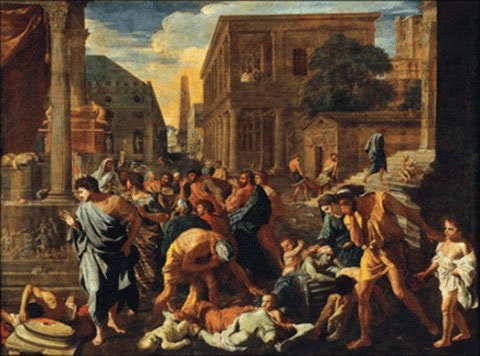7 flu pandemics that haunted human history
(Baonghean.vn) - Killing more people than war and other epidemics, the flu has long been a deadly enemy that has devastated humanity.
1. The first recorded human flu pandemic (1580)
 |
| Painting “The Plague of Ashdod” by Nicolas Poussin. Source: Wikimedia Commons |
This is considered the first influenza pandemic known to man. The epidemic originated in Asia, spread to Africa and hit Europe. According to an article in the Journal of Applied Microbiology in 2001, the epidemic devastated Spanish cities and killed 8,000 people in Rome, Italy.
The flu was so widespread that it even gave rise to the term “influenza,” which comes from the Italian phrase “influenza del freddo,” meaning “the effect of a cold.”
2. Spanish flu pandemic (1918 - 1919)
 |
| Images of patients everywhere when the Spanish flu pandemic broke out in 1918 |
It was the most severe influenza pandemic in human history. It is estimated that the flu killed between 50 million and 100 million people, of whom about 10% were young adults. The pandemic is on par with the bubonic plague, which killed nearly two-thirds of Europe's population in the mid-14th century.
3. Asian flu epidemic in 1956 - 1958
 |
| A girl gargling with salt water. Photo taken at Sagamihara Hospital, Japan during a flu outbreak in 1957. |
The years from 1956 to 1958 were marked by the Asian flu pandemic. Although not as devastating as the previous Spanish flu pandemic, the Asian flu pandemic still killed more than two million people, including 70,000 Americans.
The virus strain that caused the disease was influenza A virus, H2N2, which originated in Russia and had an outbreak in 1889. Causing a low mortality rate and short duration, Asian flu was considered a pandemic that did not threaten human civilization, but gave rise to the agent of seasonal flu.
4. Hong Kong flu epidemic in 1968
 |
| A laboratory worker injects Hong Kong flu virus into chicken eggs. |
This flu pandemic originated in Hong Kong and was caused by the influenza A virus, H3N2. According to statistics from the Pandemicflu website, the pandemic claimed 33,800 American lives. This is less than the number of deaths from the previous year's seasonal flu. The Hong Kong flu evolved from the previous Asian flu pandemic, so anyone infected with the virus in 1957 would have been immune to the 1968 strain.
5. The "strange" flu epidemic in 1976
 |
| President Gerald Ford gets a flu vaccine. |
In February 1976, a soldier at Fort Dix, New Jersey, died from the H1N1 flu virus. Fearing that the H1N1 virus was the same strain as the virus that caused the 1918-1919 pandemic, the US government called on citizens to participate in the vaccination program, and a quarter of the population responded. Sadly, for every one person who died from the flu virus, 25 died from complications of the vaccine.
6. The H5N1 avian influenza pandemic in 2003
 |
| Millions of poultry infected with H5N1 were destroyed. |
In 2003, the World Health Organization announced four deaths from H5N1 influenza virus infection. Unlike other H5N1 strains, this bird flu killed 60% of patients.
The high death rate has led to fears of a return of the dreaded Spanish flu. Fortunately, the virus is now under control. It is difficult to spread from person to person and can only be transmitted to people who come into contact with live poultry.
7. 2009 swine flu (H1N1) pandemic
 |
| The A/H1N1 influenza virus originated in pigs. |
The 2009 influenza pandemic, also known as the 2009 A/H1N1 influenza pandemic, "swine flu" (or "swine flu"), is an influenza pandemic caused by a virus of the H1N1 strain first detected by health authorities in March 2009.
By April 2009, the new strain had been identified in Canada, Spain, the United Kingdom, and was suspected to be present in several other countries, including New Zealand, where 2,400 cases of possible infection were reported.
Kim Ngoc
(Synthetic)
| RELATED NEWS |
|---|





